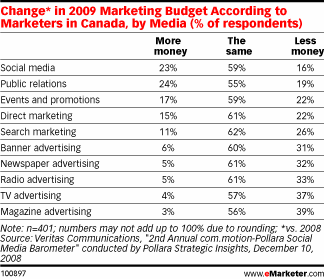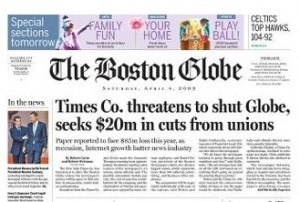“Gannett Co., the largest U.S. newspaper publisher by circulation, reports earnings on Thursday, kicking off what is expected to be the ugliest quarter in recent memory for the industry,” says The Wall Street Journal in a blunt assessment of the coming earnings season. USA Today is expected to take it on the chin when Gannett announces its results. Forthcoming numbers from the Audit Bureau of Circulations are expected to show a six-month decline of about 100,000 in USA Today‘s 2.3-million circulation, largely as a result of lower occupancy in hotels. Free hotel distribution accounts for more than half of the paper’s 2.3 million circulation.
Adding to USA Today‘s woes is Marriott’s decision to make room delivery of newspapers optional. Citing environmental concerns, the hotel chain said it will now offer guests a choice of papers or no paper at all, if they so choose. Declining readership was also a factor in the decision, which will reduce daily circulation by about 50,000 across the US. One quarter of travelers didn’t even crack open the newspaper that was delivered to their doorstep, a spokeswoman said.
Ugly Spat Over LA Times‘ Front-Page Ad
 An internal battle of the Los Angeles Times over the publisher’s decision to run a front-page ad resembling news story highlights growing tension between editors and publishers as the industry revenue woes deepen. The ad ran last Thursday below the fold in a position and typeface that some people believe could be mistaken for a news story (left). Charles Apple has an image of the entire front page. In an interview with TheWrap, LA Times executive editor John Arthur called the ad “horrible” and “a mistake.” However, the VP for entertainment advertising at the paper said Arthur’s boss, editor Russ Stanton, “approved both advertorial units.”
An internal battle of the Los Angeles Times over the publisher’s decision to run a front-page ad resembling news story highlights growing tension between editors and publishers as the industry revenue woes deepen. The ad ran last Thursday below the fold in a position and typeface that some people believe could be mistaken for a news story (left). Charles Apple has an image of the entire front page. In an interview with TheWrap, LA Times executive editor John Arthur called the ad “horrible” and “a mistake.” However, the VP for entertainment advertising at the paper said Arthur’s boss, editor Russ Stanton, “approved both advertorial units.”
Not so, says Stanton, who told the Times’ own reporter that the ad ran over his objections. “There is not an editor in this nation — including me — who really wants to see something like that on the front page of his or her publication,” Stanton said. Publisher Eddy Hartenstein said he made the decision to run the ad because of the perilous financial situation at the newspaper. “I’m just trying to keep the lights on here, folks,” he told an angry newsroom last week.
Barriers to front-page advertising have been falling recently as publishers struggle to get creative. The New York Timesshattered tradition in January with a front-page strip ad for CBS and the Boston Globe followed suit just two weeks later.
Miscellany
Newspaper executives like to point out that their total readership — including the Web — is bigger than ever. However, online ad revenue is still growing more slowly than the market as a whole, according to Alan Mutter. The most alarming recent statistic: “Interactive revenues for newspapers dropped by 1.8% in 2008 to $3.1 billion at the same time overall online ad sales in the United States surged 10.4% to a record $23.4 billion,” Mutter writes. What’s more, newspapers’ online ad revenues today are 13.3% of the overall market, the lowest share ever. Mutter suggests that the culprit is newspapers’ practice of up-selling print advertisers with discounted online campaigns, a strategy that grows weaker as print sales decline. Publishers need to develop sites that look more like the Web and less like digital versions of their print products, he advises.
The Chicago Tribune is cutting another 20% of its already depleted newsroom staff. The paper didn’t say how many employees are left in the newsroom, but there were about 440 as of the most recent layoffs in February. The paper is also reorganizing some production groups, merging copy editing, page design, graphics, imaging and some photo editing into a single department.
Writing on Slate, Jack Shafer takes on joint operating agreements as the great sucking sound that weakened the newspaper industry. “The tragedy of the joint operating agreements is that instead of making the stronger paper stronger, the arrangement tends to weaken it,” he says, pointing to the San Francisco Chronicle as the poster child example. “Had the Chronicle and the Examiner been forced to compete on the business side in 1965 instead of to collaborate, a clear victor would have a fighting chance at surviving in today’s environment.” Instead, the Chronicle was forced to support the weaker Examiner to the point that both papers were worse off.
The Gannett-owned Observer & Eccentric Newspapers will cease publication of five print and Web editions of the Eccentric chain in suburban Detroit on May 31. Gone are the Birmingham, West Bloomfield, Troy and Rochester editions of the Eccentric. Two other newspapers will be merged into the South Oakland Eccentric, serving nearby communities. The consolidation will result in the loss of 44 jobs.
The Huffington Post has published a terse set of editorial guidelines, demonstrating that the standards being applied to citizens journalists don’t differ all that much from those practiced by mainstream media.
And Finally…
 Is that a penguin on the telly? Well, a few penguins, actually, but click the image to see the truly awesome spectacle of what happens when penguins congregate. This is one of the photos on Incredimazing, a website devoted to collecting bizarre images submitted by people like you and me. If you want to scramble your brain, check out the M.C. Escher car.
Is that a penguin on the telly? Well, a few penguins, actually, but click the image to see the truly awesome spectacle of what happens when penguins congregate. This is one of the photos on Incredimazing, a website devoted to collecting bizarre images submitted by people like you and me. If you want to scramble your brain, check out the M.C. Escher car.
 Eric Alterman (right)
Eric Alterman (right) 
 The New York Times Company shocked the newspaper industry last week with its threats close the Boston Globe on May 1 unless Globe unions give back $20 million in concessions. There’s new evidence that the May 1 date is a bluff and that closing down the Globe could cost the Times more than keeping it in business.
The New York Times Company shocked the newspaper industry last week with its threats close the Boston Globe on May 1 unless Globe unions give back $20 million in concessions. There’s new evidence that the May 1 date is a bluff and that closing down the Globe could cost the Times more than keeping it in business. The Herald’s rapacious columnist, Howie Carr (left),
The Herald’s rapacious columnist, Howie Carr (left), 

 Amid all the hand-wringing about the lack of new-media alternatives to newspapers, the online-only
Amid all the hand-wringing about the lack of new-media alternatives to newspapers, the online-only  John Yemma would probably agree. As his publication, the Christian Science Monitor, goes Web-mostly, the editor (right) has launched a blog that he hopes will be “a place to talk about the changes in media.” In his second entry,
John Yemma would probably agree. As his publication, the Christian Science Monitor, goes Web-mostly, the editor (right) has launched a blog that he hopes will be “a place to talk about the changes in media.” In his second entry, 
 The Houston Chronicle joins the long string of newspapers that assert their commitment to “strong watchdog journalism” while covering news of their own troubles with e.e. cummings-like simplicity. The newspaper devotes just 208 words to news that it is laying off 12% of its staff, or nearly 200 people. That’s about one word per victim. In fact, the Chronicle doesn’t even mention a body count. You have to
The Houston Chronicle joins the long string of newspapers that assert their commitment to “strong watchdog journalism” while covering news of their own troubles with e.e. cummings-like simplicity. The newspaper devotes just 208 words to news that it is laying off 12% of its staff, or nearly 200 people. That’s about one word per victim. In fact, the Chronicle doesn’t even mention a body count. You have to 




 Today is Newspaper Death Watch’s second birthday (you can
Today is Newspaper Death Watch’s second birthday (you can 

 Mark Potts
Mark Potts 


